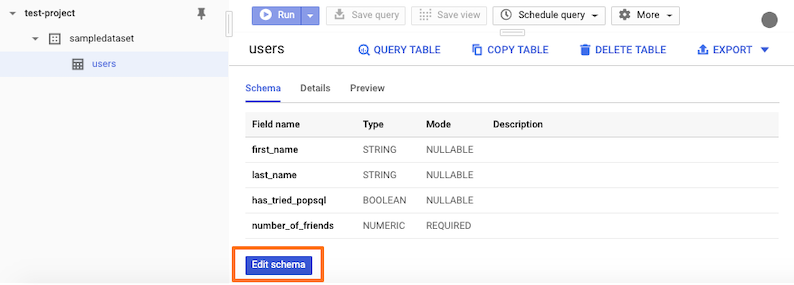How to Add a Column in BigQuery
BigQuery does not support ALTER TABLE (along with other common DDL statements).
In other words, you can't add a column via a SQL command in BigQuery. Fortunately there are three alternative methods.
Option 1. Adding a Column in the BigQuery Web UI
In the BigQuery Web UI:
- select the table you wish to alter,
- click
Edit Schema,

- click the
+ Add Fieldbutton,

- enter the desired
name,type, andmode(e.g. nullable, required, etc), - and click
Save.
Option 2. Adding a Column in the BigQuery Command Line tool
In the command line, enter:
bq update project_id:dataset.table schemaschema refers to the path to the JSON schema file on your local machine. The JSON schema file should look like:
[
{
"mode": "REQUIRED",
"name": "column1",
"type": "STRING"
},
{
"mode": "REQUIRED",
"name": "column2",
"type": "FLOAT"
},
{
"mode": "REPEATED",
"name": "column3",
"type": "STRING"
}
]Here's an example command with the path specified:
bq update myproject:mydataset.mytable /tmp/myschema.jsonOption 3. Adding a Column by calling the tables.patch API method
If you use the tables.patch API method, you have to supply the full schema (aka new and existing columns) via the API call.
Say we want to add a birthday column to our users table. We already have columns for:
first_name, a nullablestringlast_name, a nullablestringhas_tried_popsql, a nullablebooleannumber_of_friends, a requiredinteger😉
We supply the mode, name, and type for all existing columns, plus our new birthday column. It should look like this:
{
"schema": {
"fields": [
{
"mode": "NULLABLE",
"name": "first_name",
"type": "STRING"
},
{
"mode": "NULLABLE",
"name": "last_name",
"type": "STRING"
},
{
"mode": "NULLABLE",
"name": "has_tried_popsql",
"type": "BOOL"
},
{
"mode": "REQUIRED",
"name": "number_of_friends",
"type": "INT64"
},
{
"mode": "NULLABLE",
"name": "birthday",
"type": "DATE"
}
]
}
}After you submit via the API patch call, the new birthday column will be added 🎂🥳.
Note: You can also add a column in BigQuery using the
tables.updatecommand. Howevertables.patchis almost always preferred sincetables.patchonly updates the added/modified fields. Thetables.updatemethod replaces the entire table resource.
BigQuery documentation lists additional methods for adding a column (with Go, Python, etc).
Previous
How to Drop a Column